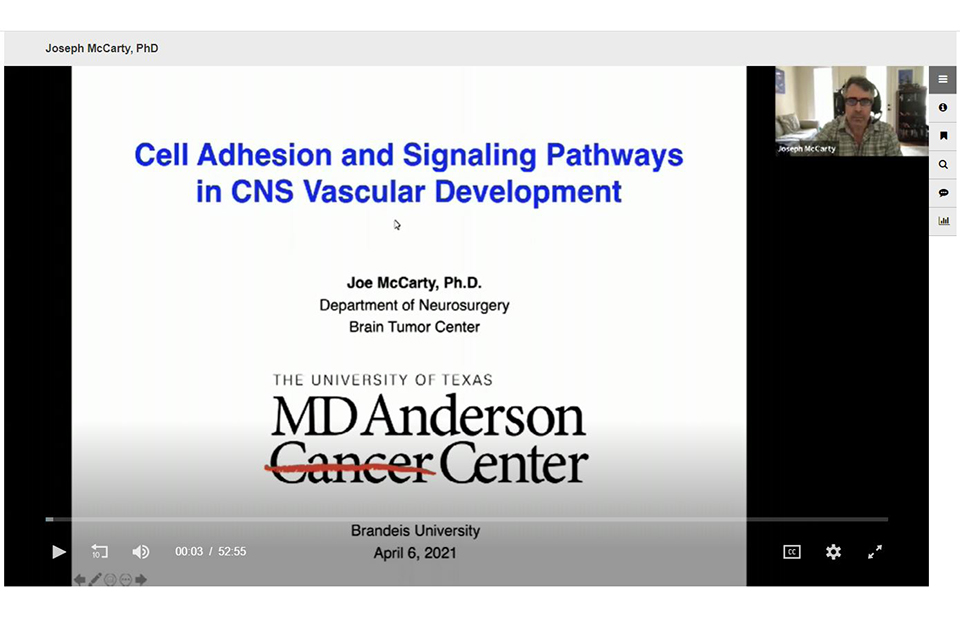Joseph McCarty, PhD
Professor
Department of Neurosurgery
University of Texas M.D. Anderson Cancer Center
(April 6, 2021)
Neurovascular signaling pathways in brain development and disease
The brain is made of more than the “little gray cells”, as described by the detective Hercule Poirot. The brain is an intricate constellation of neural cells and vascular cells, the many vessels that deliver blood throughout the brain. Problems with the vascular system can lead to disastrous results, from birth defects to stroke to cancer. Dr. McCarty discussed his work investigating the basic functions of the vascular cells in the brain, using mouse models to find the mechanisms behind normal and abnormal function, as well as new ways for drugs to pass the blood-brain barrier, a roadblock in treatment for many neurological disorders.
 Interlaced among the billions of neurons and glia in the mammalian brain is an elaborate web of arteries, veins, and capillaries. Neural cells and vascular cells form a functionally integrated network that is collectively termed the neurovascular unit. The neurovascular unit controls important developmental and physiological brain functions and is linked to the onset and progression of various pathologies. For example, ischemic and hemorrhagic vascular insults during fetal or neonatal development can lead to birth defects including leukoencephalopathy and periventricular leukomalacia. Stroke, a common adult-onset disease characterized by vascular occlusion or hemorrhage, is associated with acute disruption of the neurovascular unit and associated blood-brain barrier. Lastly, age-related pathologies such as Alzheimer’s and the malignant brain cancer glioblastoma are linked to abnormalities at the neurovascular unit.
Interlaced among the billions of neurons and glia in the mammalian brain is an elaborate web of arteries, veins, and capillaries. Neural cells and vascular cells form a functionally integrated network that is collectively termed the neurovascular unit. The neurovascular unit controls important developmental and physiological brain functions and is linked to the onset and progression of various pathologies. For example, ischemic and hemorrhagic vascular insults during fetal or neonatal development can lead to birth defects including leukoencephalopathy and periventricular leukomalacia. Stroke, a common adult-onset disease characterized by vascular occlusion or hemorrhage, is associated with acute disruption of the neurovascular unit and associated blood-brain barrier. Lastly, age-related pathologies such as Alzheimer’s and the malignant brain cancer glioblastoma are linked to abnormalities at the neurovascular unit.
More recently, we have developed mouse models that have enabled the genetic and biochemical characterization of astrocytes in the neurovascular unit. Several genes with selective expression in adult perivascular astrocytes and critical roles in neurovascular development and blood-brain barrier physiology have been identified. These genes may serve as targets for therapeutically manipulating the blood-brain barrier to improve drug delivery in patients with neurological disorders. In summary, our findings provide a unique framework for studying the cellular and molecular mechanisms underlying developmental and pathophysiological regulation of the neurovascular unit in health and disease.
